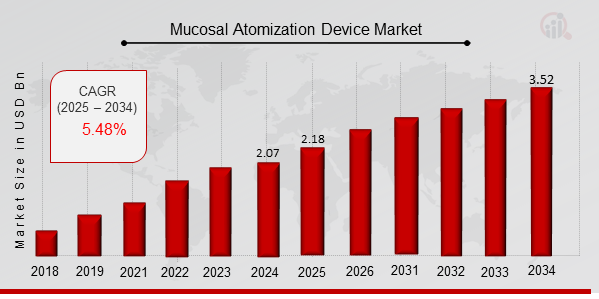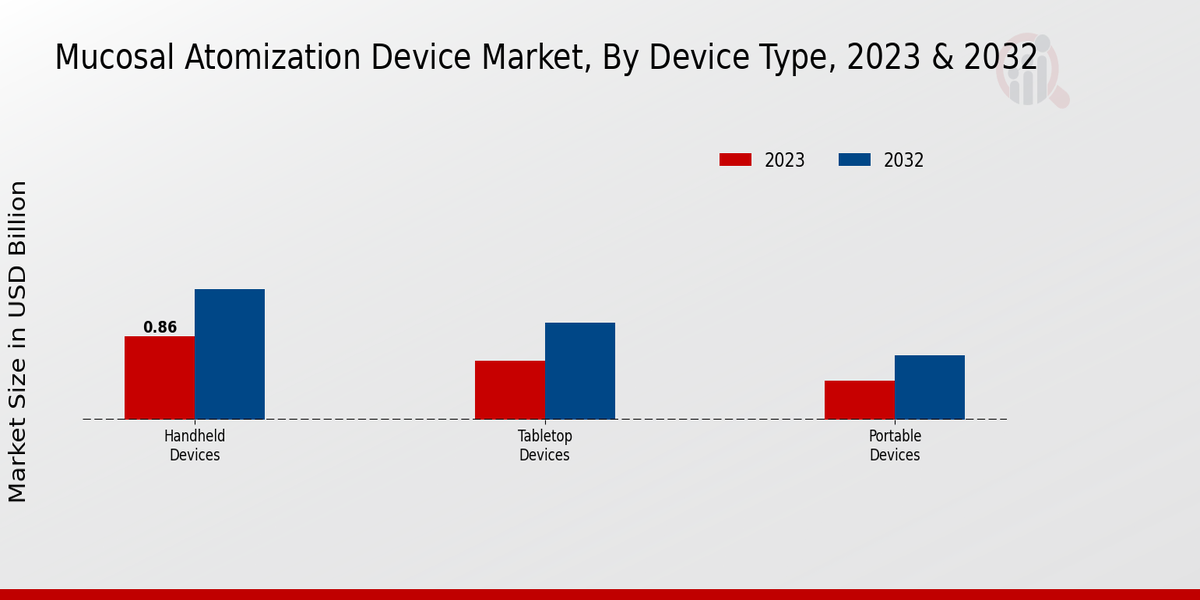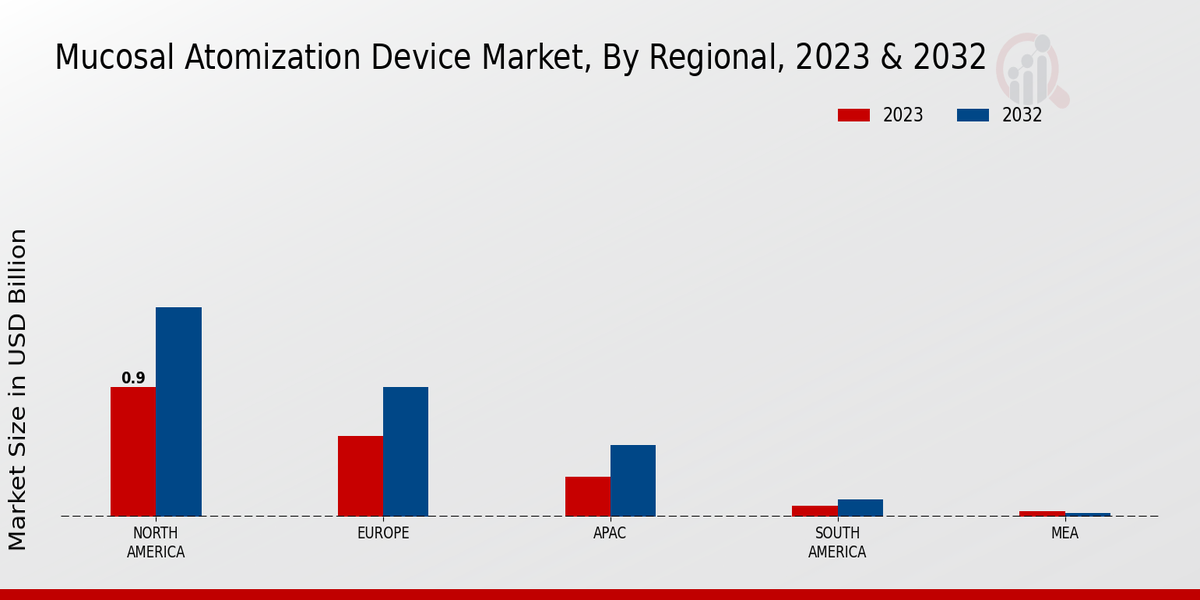Mucosal Atomization Device Market Overview
As per MRFR analysis, the Mucosal Atomization Device Market Size was estimated at 2.07 (USD Billion) in 2024. The Mucosal Atomization Device Market Industry is expected to grow from 2.18 (USD Billion) in 2025 to 3.52 (USD Billion) till 2034, at a CAGR (growth rate) is expected to be around 5.48% during the forecast period (2025 - 2034).
Key Mucosal Atomization Device Market Trends Highlighted
The Mucosal Atomization Device Market is experiencing growth driven by several key factors. An increasing prevalence of chronic respiratory diseases and a rising demand for non-invasive drug delivery methods are leading to higher adoption of mucosal atomization devices. These devices offer advantages such as ease of use, quick onset of action, and improved patient compliance, making them attractive options in both healthcare settings and at home. The shift towards personalized medicine also enhances their appeal, allowing for tailored treatment plans that meet individual patient needs. There are numerous opportunities to be captured within this expanding market.
Innovations in technology, such as advancements in atomization techniques and materials, can enhance device performance and patient experience. The potential for these devices to deliver a wide range of medications, including vaccines and therapies for various conditions, opens avenues for market players to explore new applications. Moreover, emerging markets present significant growth potential as healthcare infrastructure improvements enable wider access to modern treatment options. Recently, trends in the market indicate a growing focus on developing portable and user-friendly devices.
Manufacturers are emphasizing the importance of design and usability to cater to the preferences of both healthcare providers and patients.Additionally, the growing interest in telemedicine and remote patient monitoring is encouraging the integration of these devices into digital health solutions. As the healthcare landscape continues to evolve, these trends will likely influence the market's direction, pushing for innovations that align with patient-centric care. The convergence of technology and healthcare will shape the future of mucosal atomization devices, fostering ongoing advancements and new opportunities for growth in the market.

Source Primary Research, Secondary Research, MRFR Database and Analyst Review
Mucosal Atomization Device Market Drivers
Increasing Demand for Non-Invasive Delivery Methods
The Mucosal Atomization Device Market Industry has witnessed a significant shift in preference towards non-invasive drug delivery systems. Patients and healthcare providers alike are increasingly opting for methods that minimize discomfort and reduce the need for needles. Mucosal atomization devices are designed to deliver medications through the mucosal membranes, allowing for a more patient-friendly experience.
This transition is largely driven by advancements in technology that enable precise and efficient drug delivery, along with a growing awareness of the psychological benefits of non-invasive options.The rise in chronic illnesses and the need for continuous medication delivery without the associated pain of injections have propelled this market forward. As a result, companies in the Mucosal Atomization Device Market Industry are focusing on developing innovative products that cater to this demand.
Furthermore, hospitals and clinics are increasingly adopting these devices in their protocols, leading to higher overall utilization. This growing enthusiasm for less intrusive treatment options is anticipated to impact market trends over the coming years significantly.
Technological Advancements in Drug Delivery Systems
Technological advancements play a pivotal role in the growth of the Mucosal Atomization Device Market Industry. Ongoing research and development efforts focus on improving the efficiency and accuracy of mucosal drug delivery mechanisms. These innovations allow for better control over dosing and enhance the bioavailability of active pharmaceutical ingredients. As manufacturers introduce more sophisticated devices with features like adjustable settings and integrated feedback systems, the market for these devices is set to expand further.
Rising Awareness and Acceptance of Mucosal Delivery
Growing awareness among healthcare professionals and patients regarding the benefits of mucosal drug delivery is driving the Mucosal Atomization Device Market Industry. Increased education about the advantages, such as faster drug absorption and reduced side effects, has led to higher acceptance rates. This shift is evident in various sectors, including pediatrics and geriatrics, where needle aversion is particularly high. As medical institutions promote the use of mucosal atomization devices, the resulting push toward their adoption strengthens the market landscape and fosters further innovation.
Mucosal Atomization Device Market Segment Insights
Mucosal Atomization Device Market Device Type Insights
The Mucosal Atomization Device Market is notable for its diverse segmentation by Device Type, comprising Handheld Devices, Tabletop Devices, and Portable Devices. In 2023, the market revealed a valuation of 1.86 USD Billion, out of which Handheld Devices accounted for 0.86 USD Billion, establishing themselves as the dominant segment. This category's significance stems from its ease of use and portability, making it a preferred choice for users requiring convenience and accessibility in drug administration.
Tabletop Devices followed with a valuation of 0.6 USD Billion, offering substantial capabilities typically suited for clinical and controlled environments, thus providing significant accuracy and reliability for mucosal applications.
Portable Devices, although the smallest segment with a valuation of 0.4 USD Billion in 2023, cater to a niche market concerned with mobility while ensuring effective dosage delivery. The varying valuations among these device types reflect distinct user requirements and clinical applications, along with the evolving trends in the healthcare sector.
The anticipated growth of each segment aligns with the overall upward trajectory of the Mucosal Atomization Device Market revenue, expected to reach 3.0 USD Billion by 2032, showcasing the increasing inclination towards non-invasive drug delivery systems.
Conversely, the rapid transformations within healthcare technology are fostering innovations within Tabletop Devices, emphasizing precision in medication delivery, which is crucial for both hospital settings and outpatient treatments.
Meanwhile, the Portable Devices segment, while currently the least valued, presents unique growth opportunities as advancements in battery technology and miniaturization may facilitate the launch of more efficient and effective devices catering to specific patient populations.
However, challenges such as regulatory hurdles and the necessity for robust clinical data to support device claims persist. Overall, the Mucosal Atomization Device Market data emphasizes the dynamic nature of Device Type segmentation, with each category poised for growth, driven by innovation and shifting healthcare paradigms, which is paramount in addressing evolving consumer needs and market demands.

Source Primary Research, Secondary Research, MRFR Database and Analyst Review
Mucosal Atomization Device Market Application Insights
The Mucosal Atomization Device Market has shown significant growth, with an expected valuation of 1.86 billion USD in 2023 and a rise to 3.0 billion USD by 2032, reflecting strong market dynamics within the Application segment. Key applications within this market include Pain Management, Vaccine Delivery, and Drug Delivery, which have become increasingly vital in healthcare settings. The Pain Management application is particularly crucial due to the growing need for effective and non-invasive pain relief solutions, making it a dominant segment.
Vaccine Delivery is also gaining importance, especially in the wake of health challenges, leading to increased demand for efficient delivery systems. Additionally, Drug Delivery services leverage mucosal atomization to enhance bioavailability and patient compliance, thereby significantly influencing market growth. The integration of advanced technologies and a surge in chronic diseases further fuel opportunities in these applications alongside challenges such as regulatory hurdles.
Overall, the Mucosal Atomization Device Market offers extensive growth potential supported by evolving consumer needs and technological advancements.
Mucosal Atomization Device Market End User Insights
The Mucosal Atomization Device Market, valued at 1.86 USD Billion in 2023, is witnessing significant growth across various End-user categories, including hospitals, clinics, and home care settings. These sectors play a pivotal role in driving demand due to the increasing prevalence of chronic diseases and the surge in minimally invasive procedures. Hospitals dominate the market, offering advanced medical services and devices, thereby enhancing patient care. Clinics contribute meaningfully to this market segment, providing specialized treatment options that cater to patients seeking outpatient solutions.
Homecare settings are becoming increasingly important, driven by a growing preference for at-home treatment solutions, which improve patient convenience and adherence to medication regimens. Significant growth drivers such as technological advancements, a rise in patient awareness, and the expansion of healthcare infrastructure support the developing landscape of the Mucosal Atomization Device Market.
However, challenges such as reimbursement issues and regulatory hurdles may test the growth potential of the market. Opportunities remain plentiful, with increasing investments in research and development set to enhance the efficiency and effectiveness of mucosal atomization devices across all three End-user categories.Overall, the segmentation of the Mucosal Atomization Device Market reflects a diverse range of needs and growing market opportunities to address the evolving healthcare landscape.
Mucosal Atomization Device Market Material Type Insights
In 2023, the Mucosal Atomization Device Market was valued at 1.86 billion USD, showcasing the growing relevance of this market across various material types. The market is strategically segmented into materials such as Plastic, Metal, and Silicone, each offering unique advantages that cater to specific applications.
Plastic is currently dominating the market due to its lightweight nature and cost-effectiveness, making it a preferred choice for manufacturers and healthcare providers alike. Metal, known for its durability and reliability, appeals to settings that require long-lasting instruments, while Silicone offers flexibility and ease of use, which is essential for patient comfort.As the demand for advanced medical devices continues to rise, the Mucosal Atomization Device Market revenue is expected to thrive, fueled by the increasing adoption of these materials in innovative applications. The continuous evolution in technology and material science within the healthcare industry is propelling market growth, providing ample opportunities for development and investment across these material segments. Furthermore, understanding Mucosal Atomization Device Market segmentation can help stakeholders identify trends and capitalize on potential market opportunities, thus making informed decisions in this dynamic industry.
Mucosal Atomization Device Market Regional Insights
The Mucosal Atomization Device Market revenue highlights a diverse landscape across its regional segmentation. In 2023, North America held a significant position, attaining a market value of 0.9 USD Billion, and is projected to grow to 1.45 USD Billion by 2032, showing its dominance due to advanced healthcare infrastructure and high adoption rates.
Europe followed with a valuation of 0.56 USD Billion in 2023, expected to rise to 0.9 USD Billion, reflecting a strong focus on innovation and patient care in the region. The APAC markets hold a value of 0.28 USD Billion, advancing to 0.5 USD Billion by 2032, highlighting the growing acceptance and demand for mucosal atomization devices in emerging economies.In contrast, South America and the MEA regions present lesser market shares, with values of 0.08 USD Billion and 0.04 USD Billion in 2023, respectively, primarily due to economic constraints and less developed healthcare systems.
However, their potential for growth remains significant, driven by increasing healthcare investments and a rising awareness of advanced medical technologies. Overall, the market growth within these regions is reinforced by factors including technological advancements, higher disease awareness, and the ongoing development of healthcare services.

Source Primary Research, Secondary Research, MRFR Database and Analyst Review
Mucosal Atomization Device Market Key Players and Competitive Insights
The Mucosal Atomization Device Market is characterized by an increasing focus on innovative drug delivery systems that facilitate efficient medication administration through mucosal membranes. This market has witnessed significant growth driven by the rising prevalence of chronic diseases, advancements in medical technology, and the shift towards non-invasive delivery methods. Competitive insights reveal a landscape where key players are actively engaged in research and development to optimize the efficacy and safety of mucosal atomization devices.
Moreover, the growing emphasis on improving patient adherence and the convenience associated with these devices have bolstered their adoption across various healthcare settings. The market is characterized by intense competition, with companies continuously striving to enhance their product offerings while addressing regulatory challenges and meeting the evolving needs of healthcare providers and patients.Hektoen Institute is recognized within the Mucosal Atomization Device Market for its commitment to pioneering research and contributing valuable insights to the development of advanced mucosal delivery systems.
The institute's strengths lie in its extensive network of clinical and academic partnerships, enabling it to leverage cross-disciplinary approaches that effectively address the complexities of drug delivery via mucosal routes. Hektoen Institute has demonstrated a robust track record in conducting clinical trials and developing innovative technologies that enhance mucosal atomization techniques. Furthermore, its strong focus on collaboration promotes an environment conducive to innovation, positioning the institute as a significant player in the market and allowing it to remain at the forefront of advancements in this burgeoning field.
AstraZeneca, a leading player in the pharmaceutical industry, has made notable contributions to the Mucosal Atomization Device Market by integrating its vast expertise in drug formulation and delivery systems. The company is well-positioned to capitalize on emerging trends owing to its focus on research and development, particularly in biologics and specialty therapeutics that require efficient mucosal delivery.
AstraZeneca has established a strong presence in the market by investing in innovative technologies that improve the pharmacokinetics and patient experience associated with mucosal atomization devices. Its commitment to addressing patient needs and improving treatment outcomes further strengthens its competitive standing. With a pipeline of products under development, AstraZeneca continues to enhance its portfolio, underscoring its dedication to advancing healthcare through effective drug delivery solutions.
Key Companies in the Mucosal Atomization Device Market Include
- Hektoen Institute
- AstraZeneca
- EMED Technologies
- APTAR Pharma
- Medtronic
- Teleflex
- Purdue Pharma
- Stryker
- Pediatric Innovation
- Boehringer Ingelheim
- BD
- Avanos Medical
- Neomed
- Smiths Medical
Mucosal Atomization Device Market Industry Developments
Recent developments in the Mucosal Atomization Device Market indicate a notable surge in demand due to the increasing use of these devices in the administration of drugs for both local and systemic effects. Companies such as AstraZeneca and Boehringer Ingelheim are expanding their portfolios to include innovative atomization technologies that enhance drug delivery efficiency. Meanwhile, EMED Technologies and APTAR Pharma are investing in research and development for advanced mucosal delivery systems, which is reflective of the growing emphasis on patient-centric solutions in this sector.
In the context of mergers and acquisitions, Hektoen Institute has recently engaged in collaboration discussions with medical firms, including Teleflex, to enhance research capabilities in mucosal atomization technologies. Growth in market valuation is evident as many of these firms, including Medtronic and Stryker, are experiencing increased stock performance, which in turn is fueling investment in new product development. The ongoing innovation and strategic partnerships within this market underlie the potential for substantial advancements in the efficiency and effectiveness of drug delivery mechanisms in healthcare.
Mucosal Atomization Device Market Segmentation Insights
Mucosal Atomization Device Market Device Type Outlook
- Handheld Devices
- Tabletop Devices
- Portable Devices
Mucosal Atomization Device Market Application Outlook
Mucosal Atomization Device Market End User Outlook
- Hospitals
- Clinics
- Homecare Settings
Mucosal Atomization Device Market Material Type Outlook
Mucosal Atomization Device Market Regional Outlook
- North America
- Europe
- South America
- Asia-Pacific
- Middle East and Africa
| Report Attribute/Metric |
Details |
|
Market Size 2024
|
2.07 (USD Billion)
|
|
Market Size 2025
|
2.18 (USD Billion)
|
|
Market Size 2034
|
3.52 (USD Billion)
|
|
Compound Annual Growth Rate (CAGR)
|
5.48 % (2025 - 2034)
|
|
Report Coverage
|
Revenue Forecast, Competitive Landscape, Growth Factors, and Trends
|
|
Base Year
|
2024
|
|
Market Forecast Period
|
2025 - 2034
|
|
Historical Data
|
2020 - 2024
|
| Market Forecast Units |
USD Billion |
| Key Companies Profiled |
Hektoen Institute, AstraZeneca, EMED Technologies, APTAR Pharma, Medtronic, Teleflex, Purdue Pharma, Stryker, Pediatric Innovation, Boehringer Ingelheim, BD, Avanos Medical, Neomed, Smiths Medical |
| Segments Covered |
Device Type, Application, End User, Material Type, Regional |
| Key Market Opportunities |
Increased demand for pain management, Growth in non-invasive drug delivery, Rising prevalence of chronic diseases, Expanding applications in vaccine administration, Technological advancements in atomization devices |
| Key Market Dynamics |
Increasing prevalence of chronic diseases, Rising demand for needle-free delivery, Technological advancements in atomization, Growing applications in pain management, Expanding research and development initiatives |
| Countries Covered |
North America, Europe, APAC, South America, MEA |
Frequently Asked Questions (FAQ) :
The projected market size of the Mucosal Atomization Device Market is expected to reach 3.52 USD Billion by 2034.
The expected CAGR for the Mucosal Atomization Device Market from 2025 to 2034 is 5.48%.
North America is expected to hold the largest market share in the Mucosal Atomization Device Market, projected to reach 1.45 USD Billion by 2032.
The market size for Handheld Devices in the Mucosal Atomization Device Market was valued at 0.86 USD Billion in 2023.
Major players in the Mucosal Atomization Device Market include Hektoen Institute, AstraZeneca, EMED Technologies, and Medtronic, among others.
The anticipated market value for Tabletop Devices is expected to be 1.0 USD Billion by 2032.
The market for Portable Devices is expected to grow from 0.4 USD Billion in 2023 to 0.66 USD Billion by 2032.
The market size for the European region is projected to be 0.9 USD Billion by 2032.
The Mucosal Atomization Device Market faces challenges, including regulatory hurdles and competition from alternative delivery methods.
The growth of the Mucosal Atomization Device Market is driven by innovation in drug delivery systems and rising demand for non-invasive administration methods.

















